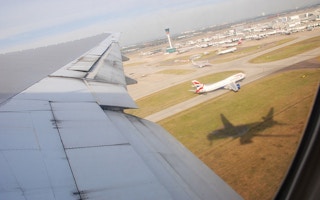Airports are a major part of a country’s infrastructure. In addition to being travel hubs, they also enable economic activities and play a key role in national security. But many are vulnerable to sea level rise, especially those established in low-lying coastal areas.
Using sea level rise data from Climate Central and airport locations from OpenFlights, we found that 80 airports could be underwater with one metre of sea level rise, which researchers at the UN’s expert climate panel predict is likely to occur by 2100 if emissions aren’t reduced.
Even if emissions are curtailed and warming is limited to 2 degrees C (3.6 degrees F), about half a metre of sea level rise is likely by the end of the century, which would flood 44 airports around the world.
The reason airports are threatened by sea level rise is simple: many of them capitalise on low, flat areas, which are required for long runways to facilitate takeoff and landing. Airplanes need room to gain altitude, which they can easily do over bodies of water, without worrying about tall buildings.
This type of land is typically found near large bodies of water — wetlands, marshlands and floodplains — areas that are especially susceptible to sea level rise and storm surge. But while building airports near bodies of water started off as an advantage, it is now quickly becoming a liability due to climate change.
Which airports are most at risk
Airports are at risk all over the world, but the highest number of affected airports are in North America, Europe and Asia, because there are more airports on these continents. The images below show the impact sea level rise would have on select airports.
North America
Six airports in North America could be underwater with just half a metre of sea level rise. This figure increases to 12 at one metre of sea level rise and includes airports such as Key West International Airport and Jacqueline Cochran Regional Airport.
Key West International Airport, located in Florida, has between 50 and 60 commercial airline flights each day and registered 870,000 passengers in 2018, according to its website. The visual below shows the impact of expected flooding on this airport with half a metre of sea level rise.

In California, the Jacqueline Cochran Regional Airport averages 209 aircraft operations a day and has 127 aircrafts based at the airport. Located near the Salton Sea, this airport would be completely flooded with only half a metre of sea level rise.
Europe
Within Europe, 11 airports are at risk of being underwater with half a metre of sea level rise, and 23 are at risk if sea level rise reaches one metre.
Amsterdam’s Airport Schiphol is the 11th busiest airport in the world and is predicted to be underwater with only half a metre of sea level rise. However, it’s important to note that while the Climate Central maps show areas below certain sea-levels, they do not take into account flood barriers and other water management technologies implemented in the Netherlands.

The Dutch have particularly strong water management strategies, such as building dikes, seawalls, and underground spaces where water can safely pool in the event of flooding. These measures, which are not reflected in the maps developed by Climate Central, are designed to mitigate flood impact on infrastructure and reflect a significant investment in water-management technologies.
Another European airport at risk from just half a metre of sea level rise is Denmark’s Kalundborg Airport. The map below shows the location of airport overlaid with half a metre of sea level rise.
Asia
Seven of Asia’s airports are at risk from half a metre of sea level rise, and 14 are at risk from one metre of sea level rise, including China’s Yancheng Airport and Iran’s Ramsar International Airport.
Yancheng Airport, seen below, could be flooded by only half a metre of sea level rise. This airport, located in Jiangsu Province, China, is a hub for both commercial and international flights, and averages 44 flights a day.
Ramsar International Airport is situated on the coast of the Caspian Sea. Half a metre of sea level rise would flood part of Ramsar Airport’s runways.
A turbulent future for air travel
While 80 airports would be inundated with one metre of sea level rise, they’re hardly the only ones affected by climate change. Lots of airports will feel the effects of storm surge and extreme weather, even if they’re not completely submerged by rising seas.
We are already getting a taste of what that could look like. LaGuardia, John F. Kennedy International Airport, and Newark (N.J.) International Airport all experienced severe flooding from nearby water bodies during Hurricane Sandy in 2012. This flooding caused around 10,000 canceled flights and millions of dollars in lost revenue.
And in September 2018, Kansai International Airport in Japan became surrounded by ocean in the aftermath of a typhoon. These events showcase what may be the new normal for airports once the rising waters of climate change become more permanent.
Other aspects of climate change threaten air travel. Extreme heat, which comes with thinner air, has the potential to ground planes by making them unable to generate lift, and also may make air travel more turbulent.
As the implications of sea level rise are becoming better understood, many airport managers are acting to protect airports in the near-term. Singapore’s Changi airport has recently resurfaced its runways to allow for better drainage and is building expansions on higher elevations.
In the United States, Boston Logan Airport and San Francisco International Airport have worked to install new flood barriers to stave off rising seas. Last October, officials at San Francisco International Airport decided to move ahead with a $587 million plan to build up the airport’s seawall from three feet to eight feet tall.
Tina Huang and Noah Maghsadi are from the World Resources Institute. This post originally appeared on Resource Watch, a WRI data platform. Visit Resource Watch to explore more climate change and natural resource data.
















